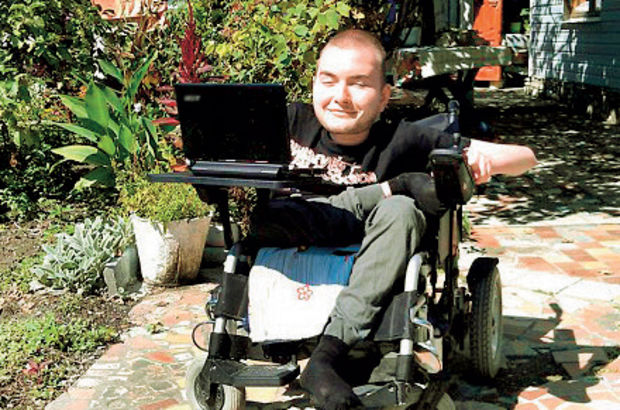In Russia, a 30-year-old man has volunteered to become the world’s first head transplant. Valery Spiridonov (pictured) has a rare genetic disordered called Werdnig-Hoffman disease, which is a severe form of spinal muscular dystrophy. Italian surgeon, Dr. Sergio Canavero, plans to conduct the operation.
The operation is considered highly controversial but Dr. Canavero believes he can cut off Spiridonov’s head and attach it to a healthy body. According to the Daily Mail, both donor and patient would have their head severed from their spinal cord at the same time. Then the patient’s head would be placed onto the donor’s body and attached using a substance called polyethylene glycol (PEG) that would fuse the two ends of the spinal cord together. After the procedure, the patient would be put into a coma for a month to ensure that the head and body heal together. Additionally, the patient would be given powerful immunosuppressant drugs to stop the new body from being rejected.
 Spiridonov explained that he was the one who contacted Dr. Canavero about the operation. He said, “I offered myself to him to make this operation possible. We have never met and we just communicate via emails. For the last two years we’ve been talking this idea through and planning the operation. He’s a very experienced neurosurgeon and has conducted many serious operations. Of course he has never done anything like this and we have to think carefully through all the possible risks.”
Spiridonov explained that he was the one who contacted Dr. Canavero about the operation. He said, “I offered myself to him to make this operation possible. We have never met and we just communicate via emails. For the last two years we’ve been talking this idea through and planning the operation. He’s a very experienced neurosurgeon and has conducted many serious operations. Of course he has never done anything like this and we have to think carefully through all the possible risks.”
He added, “My decision is final and I do not plan to change my mind. Am I afraid? Yes, of course I am. But it is not just very scary, but also very interesting. You have to understand that I don’t really have many choices. If I don’t try this chance my fate will be very sad. With every year my state is getting worse.”
Like this pro-life news article? Please support LifeNews during our current fundraising campaign with a donation!
However, countless doctors are urging Spiridonov not to go through with the procedure. The president of the American Association for Neurological Surgeons, Dr. Hunt Batjer, told CNN, “I would not wish this on anyone. I would not allow anyone to do it to me as there are a lot of things worse than death.”
Spiridonov disagrees. He said, “I can hardly control my body now. I need help every day, every minute. I am now 30 years old, although people rarely live to more than 20 with this disease. My muscles stopped any development in childhood. Because of this, they do not grow and the skeleton gets deformed. The back muscles cannot support the skeleton.”
He continued, “I do understand the risks of such surgery. They are multiple. We can’t even imagine what exactly can go wrong. I’m afraid that I wouldn’t live long enough to see it happen to someone else. What’s more, there’s already a lot of effort invested in this idea and that’s why it’s too late to back out. I came up with this idea quite some time ago. I read many scientific articles on this topic.”
Now Dr. Canavero is searching for a major medical center to host the surgery. Ideally, he wants to perform the operation in the United States and is planning to present his plan to the American Academy of Neurological and Orthopedic Surgeons (AANOS) in June. The AANOS has made it clear that they aren’t endorsing Dr. Canavero; rather, they are simply giving him a platform to hear what he has to say.
In 2013, CBS News reported that Dr. Jerry Silver and a team of scientists at Case Western and the Cleveland Clinic successfully restored connectivity in rats whose spinal cords had been completely severed. This encouraged Dr. Canavero, who said such recent advances in reconnective technology give scientists reason to believe the procedure he proposes will be successful in humans.
Not only did Dr. Silver think the correlation was laughable, he was appalled.
“It’s complete fantasy, that you could use [PEG technology] in such a traumatic injury in an adult mammal. He concluded, “To severe a head and even contemplate the possibility of gluing axons back properly across the lesion to their neighbors is pure and utter fantasy in my opinion. Just to do the experiments is unethical. This is bad science, this should never happen.”








